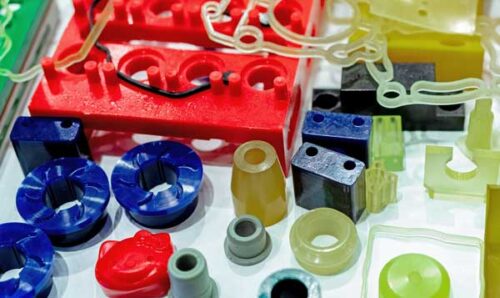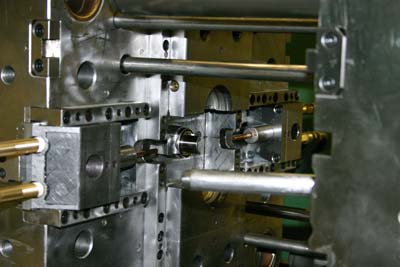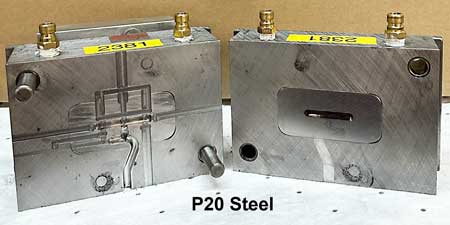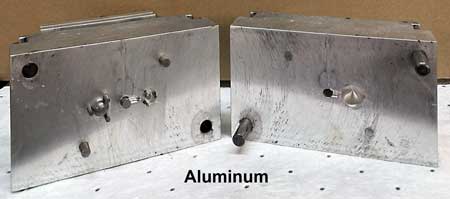Plastic Injection Molding Process Variables
Leave a Comment
Injection molding can be a complex process, with many factors influencing the quality of the final plastic part. Successful production relies on several critical factors including part design, material selection, tool design, and an optimized manufacturing process. While it’s important to focus on these, another key to part quality and consistency lies in understanding and controlling the behavior of the molten plastic. Today, we’ll look at the four primary thermoplastic variables – temperature, flow rate, pressure, and cooling. We’ll explain the role of each and how mastering them can lead to more predictable and successful molding outcomes.
But before we jump into material variables, let’s take a step back and consider the complexity of the machinery: injection molding machines come equipped with a range of machine control options that significantly influence the movement of polymer from the container to the mold cavity. Key machine variables include barrel temperature, hydraulic pressure, hydraulic flow rate, oil temperature, function times, and clamp force.
Understanding Thermoplastic Variables
Thermoplastic variables can be distilled down to four main ones as follows:
- Plastic Temperature
- Plastic Flow Rate
- Plastic Pressure
- Plastic Cooling Rate/Time
It’s important to note that the measurement of plastic variables operates independently of machine variables and can be consistently replicated across different injection molding machines.
Plastic temperature, or melt condition, is influenced by several factors, including barrel temperatures, screw design, screw check valve design, screw rotation speed, back pressure, and residence time. To ensure accuracy, plastic temperature should be measured using a calibrated, pre-heated pyrometer positioned in a purge puddle taken during the cycle, while machine temperature controllers must be properly calibrated and tuned. Monitoring the consistency of screw recovery time is also essential.
Plastic flow rate represents the time taken from the start of injection until the process transitions to packing/holding when the mold is filled to 95-99%. This fill time differs from the first stage timer setting. By combining fill time with a shot volume calculation, one can derive a volumetric flow rate, which constitutes a vital plastic variable measurement. The plastic flow rate directly influences the viscosity of the polymer melt as it enters the mold cavity. As the plastic molecules flow, they untangle, align, and effectively reduce viscosity, allowing for smoother processing. Because of this relationship, maintaining consistent fill times from shot to shot and run to run is crucial.
Plastic pressure quantifies the compression level of the polymer within the mold cavity at the end of the molding cycle. Proper control of the polymer quantity introduced into the mold and the amount held in the cavity until the gate solidifies is paramount. The key machine controls that govern plastic pressure include pack pressure, pack time, hold pressure, and hold time. The most effective method for measuring plastic pressure within the molded part is through the use of cavity pressure transducers.
Cooling rate and time of the plastic have notable impacts on the final part dimensions, appearance, and cycle time. The temperature of the mold surface plays a vital role in determining part aesthetics and performance by influencing the thickness of the oriented layer of plastic molecules. During the filling process, most of the molten plastic’s heat must be transferred to the mold cavity, and subsequently removed. While some heat is lost through radiation, the majority is dissipated through forced convection via the cooling channels in the mold.
Optimizing heat transfer requires ensuring turbulent flow in cooling channels, maintaining them free of scale that can insulate, directing coolant flow to areas most in need, and maximizing the time the plastic is in contact with the cavity surface. Comparing the inlet and outlet coolant temperatures in each circuit can help assess heat removal performance; a temperature difference of 4°F or more is indicative of inadequate heat removal.
Conclusion
Understanding how machine variables impact the key injection molding variables streamlines process optimization and troubleshooting. Mastery of these variables and the process, which comes from experience and a deep understanding of how they are all inter-related, will help ensure a predictable and positive outcome for any size production run.









 Molded thermoplastics may be worked using a few different methods: injection molding, blow molding, and extrusion. Injection molding involves heating plastic pellets to a molten state, injecting it into a mold cavity under high pressure, then allowing it to cool and solidify.
Molded thermoplastics may be worked using a few different methods: injection molding, blow molding, and extrusion. Injection molding involves heating plastic pellets to a molten state, injecting it into a mold cavity under high pressure, then allowing it to cool and solidify. Thermosetting plastics, simply known as thermosets, are polymers that undergo a chemical change when heated, thus forming a rigid structure. Once set, they cannot be remelted or reshaped. When compared to thermoplastics, they are usually more stable, but also more brittle. Typical materials include Epoxy, Phenolic, Melamine, Urea-formaldehyde, and Polyester resins.
Thermosetting plastics, simply known as thermosets, are polymers that undergo a chemical change when heated, thus forming a rigid structure. Once set, they cannot be remelted or reshaped. When compared to thermoplastics, they are usually more stable, but also more brittle. Typical materials include Epoxy, Phenolic, Melamine, Urea-formaldehyde, and Polyester resins. This process involves shaping rubber materials, which can be either natural or synthetic rubber (elastomers). Rubber has high elasticity and abrasion resistance with good tensile strength. These properties vary based on the type used, which include Natural Rubber, Neoprene, and Nitrile Rubber.
This process involves shaping rubber materials, which can be either natural or synthetic rubber (elastomers). Rubber has high elasticity and abrasion resistance with good tensile strength. These properties vary based on the type used, which include Natural Rubber, Neoprene, and Nitrile Rubber.

 will utilize inline part inspection to help ensure part quality. With this critical step, an image of the finished part is taken, compared to a reference image, and is either accepted, or, sadly, pushed into the reject bin. (But don’t be too sad, that part will get a second chance here at PDI, since we recycle all excess plastic inline!)
will utilize inline part inspection to help ensure part quality. With this critical step, an image of the finished part is taken, compared to a reference image, and is either accepted, or, sadly, pushed into the reject bin. (But don’t be too sad, that part will get a second chance here at PDI, since we recycle all excess plastic inline!)




 There are three aspects of plastic part design that are often overlooked, but crucial for manufacturing success: surface finish, texture, and draft angles. Understanding and optimizing each is critical for fabricating consistent, high quality plastic components efficiently.
There are three aspects of plastic part design that are often overlooked, but crucial for manufacturing success: surface finish, texture, and draft angles. Understanding and optimizing each is critical for fabricating consistent, high quality plastic components efficiently. Texture – helps enhance the look, functionality, and performance of the finished component. Common options include leather-like, pebble/sandblasted, geometric patterns, and micro textures. Leather-like finishes enhance aesthetics, functionality, and performance. Pebble or sandblasted textures are durable and hide scratches. Geometric patterns provide functional grip, but may also be used for decorative purposes. Finally, micro-textures are ideal for parts where glare reduction or wear resistance is desired. Note that fine textures might require more intricate mold designs. One last thought on texture: textured molds can be more expensive to manufacture.
Texture – helps enhance the look, functionality, and performance of the finished component. Common options include leather-like, pebble/sandblasted, geometric patterns, and micro textures. Leather-like finishes enhance aesthetics, functionality, and performance. Pebble or sandblasted textures are durable and hide scratches. Geometric patterns provide functional grip, but may also be used for decorative purposes. Finally, micro-textures are ideal for parts where glare reduction or wear resistance is desired. Note that fine textures might require more intricate mold designs. One last thought on texture: textured molds can be more expensive to manufacture. Improved Quality – Proper mold maintenance will lead to higher quality products by preventing defects such as flash, sink marks, and warpage.
Improved Quality – Proper mold maintenance will lead to higher quality products by preventing defects such as flash, sink marks, and warpage. When it comes to creating prototype molds for injection molding, choosing the right material is crucial. Two common options for prototype mold construction are aluminum and soft steel (P20). Today, we’ll compare these two materials to help you make an informed decision. For the purposes of today’s discussion, we’ll be talking about “late stage” prototype molds. These are molds that are likely to be used for medium to high volume production runs, not just to knock out a few early-stage prototypes.
When it comes to creating prototype molds for injection molding, choosing the right material is crucial. Two common options for prototype mold construction are aluminum and soft steel (P20). Today, we’ll compare these two materials to help you make an informed decision. For the purposes of today’s discussion, we’ll be talking about “late stage” prototype molds. These are molds that are likely to be used for medium to high volume production runs, not just to knock out a few early-stage prototypes. Heat Conduction – aluminum dissipates heat quickly and efficiently, meaning reduced cooling time during the injection molding process. Steel holds heat longer, leading to extended cooling times, which could lengthen production time. Also consider the required melting point of the material being molded. For those that require higher values, steel is the way to go.
Heat Conduction – aluminum dissipates heat quickly and efficiently, meaning reduced cooling time during the injection molding process. Steel holds heat longer, leading to extended cooling times, which could lengthen production time. Also consider the required melting point of the material being molded. For those that require higher values, steel is the way to go.